Molecular mechanism study of Astragalus adsurgens Pall synergistically induced by plasma and plasma-activated water
Yibing LI(李一冰),Tao ZHANG(张涛),Zhiqing SONG(宋智青),Changjiang DING(丁昌江) and Hao CHEN(陈浩)
1 Application Laboratory for Discharge Plasma &Functional Materials,Inner Mongolia University of Technology,Hohhot 010051,People’s Republic of China
2 College of Science,Inner Mongolia University of Technology,Hohhot 010051,People’s Republic of China
3 Center for Energy Conservation and Emission Reduction in Fermentation Industry of Inner Mongolia Autonomous Region,Hohhot 010051,People’s Republic of China
4 Engineering Research Center of Inner Mongolia for Green Manufacturing in Bio-fermentation Industry,Hohhot 010051,People’s Republic of China
5 Yibing LI and Tao ZHANG contributed equally to this work.
Abstract The mutagenic effects of discharge plasma and plasma+PAW(plasma and its activated water combined)on Astragalus adsurgens Pall seeds were explored.Needle array-plate dielectric-barrier discharge plasma was used to treat A.adsurgens Pall seeds and PAW was prepared at the same time.The deionized water and the obtained PAW were used to cultivate plasma-treated seeds in groups and the survival rate of each group was counted.Results showed that the survival rate of the treated seeds of A.adsurgens Pall when cultured with deionized water was not significantly different from that of the control check(CK).The culture with PAW had an obvious lethal effect and each group reached the half-lethal dose.Reactive oxygen species(ROS)and RNA-Seq analysis of seedlings in the 3 h treatment group showed that the content of ROS in the 3 d post-treatment group was significantly higher than that of the CK.Because expression of the gene with the function of scavenging superoxide free radicals was upregulated,the ROS content of seedlings on the sixth day was significantly lower than that on the third day.Plasma and plasma+PAW treatments changed a large number of gene expressions;particularly,the plasma+PAW group caused plant-growth genes to be significantly upregulated.After treatment,the seedlings of A.adsurgens Pall may grow faster and have higher nutritional value.This research is of great significance to the wider application of isoelectronic bodies and their activated water physicochemical mutagens in biological effects and breeding research.
Keywords:Astragalus adsurgens Pall,plasma activated water(PAW),plasma,RNA-Seq,molecular mechanisms
1.Introduction
Astragalus adsurgensPall is a perennial herb belonging to the genusAstragalusin the leguminous family.A.adsurgensPall has high nutritional value as feed and it is also extensively used in returning farmland to grassland.It grows rapidly and has the characteristics of barren-environment tolerance,wide adaptability and strong resistance,thereby playing an important role in the restoration of degraded ecosystems[1,2].Therefore,the mutation breeding ofAstragalus adsurgensPall and the breeding of excellent varieties are of great significance in promoting the breeding of leguminous crops,leguminous forages and ecological reconstruction.
In recent years,plasma has been extensively used to promote seed germination[3]and plant growth.Researchers have found that the effect of plasma on seeds is primarily reflected in etching of the seed coat,improving hydrophilicity[4]and promoting growth.In addition,plasma treatment of seeds can also increase the nutrient absorption of tomato seedlings[5],improve the protein content of wheat,promote growth,improve drought resistance[6–8]and has the potential to improve the yield of rape[9].Plasma treatment of seeds has been widely investigated.Previous studies have shown that the penetration depth of the legumeMedicago sativaL seed coat by discharge plasma is in the order of microns[10],which cannot affect the seed embryo.However,PAW can break through the seed-coat barrier,and the reactive oxygen and nitrogen species(RONS)in PAW uses water as the carrier.Thus,reaching the embryo of the seed becomes easier when dealing with the seed.For this reason,PAW is used to treat seeds and has been shown to promote germination of different seeds,such as soybeans[11],mung beans[12],wheat[13]and cress[14].
At present,studies on the effects of plasma and plasma and its activated water combined(PAW)on plant seeds remain at the stage of stimulating plant growth.Thede novoassembly of RNA-Seq data is the most effective method of obtaining biological transcriptional sequences[15]and this strategy is extensively used in the field of plant genesequencing analysis.However,previous studies mostly compared different varieties of the same plant[1],evaluated the response of different varieties to low temperature[16],analysed gene differences at different growth stages of plants[17]and assessed the mechanism of plant gene protection under salt stress[18].In conclusion,the high mortality of the co-treatment of discharge plasma and PAW has not been reported in mutation breeding;especially,the molecular mechanism of the co-treatment has not been reported.
In this study,we used a needle array-plate dielectricbarrier discharge(DBD)device[19].The discharge plasma generated by the device produced physical and chemical etching on the seed coat ofA.adsurgensPall.Then,the seeds were cultured with deionized water and PAW prepared under the same conditions to analyse the survival ofA.adsurgensPall.RNA-Seq was performed on seedlings of different treatment groups and control groups,and differential-gene enrichment analysis was conducted.The effects of plasma and plasma and PAW synergistic onA.adsurgensPall were studied at a molecular level.
2.Materials and methods
2.1.Experimental device
A needle array-plate DBD device was used in this study(figure 1)[19].The power supply of the experimental device was AC.The frequency was 50 Hz and the voltage was continuously adjustable from 0 to 50 kV(light duty high-voltage test transformer,YDJZ).The high-voltage electrode was composed of a needle array with a length of 2 cm,needle diameter of 1.56±0.02 mm,curvature radius of 0.75 mm and horizontal and vertical spacing of 4 cm(14×seven needles).The grounding end was a 2 mm thick planar aluminium plate(85×45 cm2)covered with a 4 mm thick polymethyl methacrylate dielectric plate(100×60 cm2).The whole electrode system was enclosed using a dark box to create a relatively closed experimental environment,which could allow air to enter and effectively reduce the diffusion speed of the discharge plasma to the outside world,making the plasma effect more obvious.Because the activation effect was very good when the voltage was 25 kV and the distance between the needle tip and the dielectric plate was 4 cm(the distance from the needle tip to the water surface is 3.675 cm)[19],we carried out the experiment according to these parameters.
2.2.Plasma diagnosis
An SLR camera(Nikon D7000)was used to capture images of the discharge.A spectrometer(Kymera AN-DOR 328i)was used to collect the plasma-emission spectra during the discharge process to diagnose the types of particles in the plasma(spectrometer focal length:328 mm;image resolution:0.44–0.31 nm continuously adjustable;detector type:DH334T-16F-E3).
2.3.PAW detection
We used a graduated cylinder to measure 50 ml of deionized water(UPR-I-60L UPR pure water manufacturing system)with an initial conductivity of 2.93 μS cm−1and placed it in a polypropylene Petri dish with an inner diameter of 14 cm.With a voltage of 25 kV and a distance of 4 cm between the needle and the medium plate,the water was activated for 1,2 and 3 h,respectively.Long-lived reactive species concentrations were measured using a micro-UV/Vis spectrophotometer(NanoDrop Onec)and a content detection kit.A H2O2content detection kit(Beijing Solarbio Science &Technology Co.,Ltd.)was used to detect H2O2concentration(H2O2reacted with titanium sulphate to form a yellow titanium peroxide compound and a characteristic absorption peak was observed at 415 nm).A soil and water NO2−content detection kit(Beijing Solarbio Science &Technology Co.,Ltd.)was used to detect NO2−concentration(under acidic conditions,NO2−reacted with 3-aminobenzene sulphonic acid to form diazo-compound,which then reacted with N-1-naphthylethylenediamine hihydrochloride to form purplish azo compounds.A characteristic absorption peak was observed at 540 nm).A nitrate-ion determination kit in water(G0426F Grace Biotechnology Co.,Ltd.)was used to detect NO3−concentration(the interference of NO2−was decomposed and removed by adding sulphamic acid).A pH meter(PHS-2F)was used to measure PAW’s pH with an accuracy of 0.01,and a conductivity meter(DDS-307A)was used to measure its conductivity with an accuracy of 0.1.
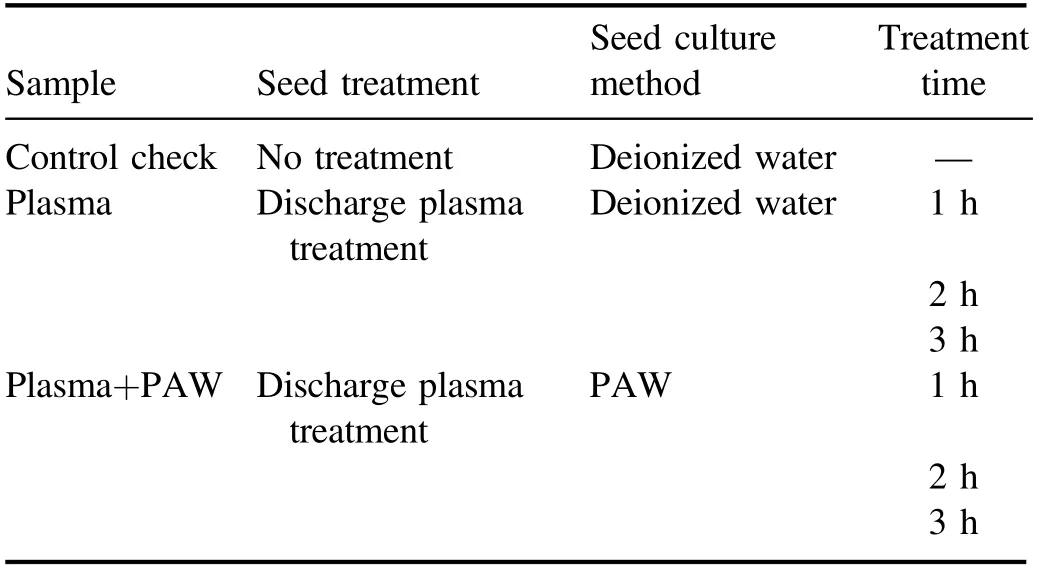
Table 1.Sample and treatment conditions.
2.4.Seed culture of A.adsurgens Pall
We selected full and completeA.adsurgensPall seeds(50 seeds per dish for treatment).The PAW activation time of 1 h makes the seeds semi-lethal and an activation time of 3 h had a more obvious lethal effect on seeds;therefore,with a voltage of 25 kV and a distance of 4 cm between the needle tip and the dielectric plate,the seeds and deionized water were treated for 1,2 and 3 h,respectively.The effects of plasma alone and the synergistic effect of plasma and PAW onA.adsurgensPall seeds were analysed.The grouping process is shown in table 1.
We placed the seeds treated under different conditions in a Petri dish containing three layers of filter paper.Every other day,1 ml deionized water was added to the Petri dish of the control check(CK)and plasma groups,and 1 ml PAW prepared under the same conditions was added to the plasma+PAW group to ensure that the water completely soaked the filter paper.The seeds were placed in a light incubator at a constant temperature of 24 °C.After the seeds were germinated,the light incubator was irradiated with 100 Lux light continuously for 14 h and placed in darkness for 10 h.
2.5.Seed survival rate of A.adsurgens Pall
The survival rate was counted 6 d later.The formula of seed survival rate was as follows:

whereSis the survival rate,Nis the total number of seeds,andn6is the number of germinations on the sixth day.
2.6.Seedling reactive oxygen species(ROS) content test
From the same treated seedlings,1.5 g was randomly selected on the third and sixth days of inoculation.ROS were measured after the ice bath was ground.The substrate used for the assay was 2′,7′-dichlorodihydrofluorescein diacetate.The sample to be tested was reacted with 10 mM CM-H2DCFDA at 25°C for 30 min in darkness according to the method of Babuet al[20].The sample was then placed in a 96-well plate containing 100 μl of distilled water in darkness and then placed in a microplate reader(Spectramax I3,Molecular Devices Corporation).The excitation intensity of 530 nm was detected by excitation with an excitation light of 485 nm.This step was repeated six times or more.
2.7.RNA-Seq
An ethanol precipitation protocol and CTAB-PBIOZOL reagent were used to purify total RNA from plant tissue according to the manufacturer’s instructions.After fragmenting the RNA with an interrupted buffer,reverse transcription was performed to synthesize DNA and construct a single-stranded circular DNA library.We used the DNBSEQ platform to measure data.The sequencing result software(SOAPnuke v1.4.0)was used for filtering,Trinity(v2.0.6)was used to assemble clean reads after filtering,and Tgicl was used to cluster the transcripts to remove redundancy and obtain Unigenes and to qualify the assembled Unigenes.The assembled Unigenes were evaluated and annotated into seven functional databases(KEGG,GO,NR,NT,SwissProt,Pfam and KOG).Statistically significant differentially expressed genes were screened according to the gene expression level of each sample,and KEGG and GO function distribution analyses were performed on the differential genes.We then screened the genes with significant upregulation and downregulation and analysed their functions.
2.8.qRT-PCR verification
In order to verify the reliability of the RNA-seq results,six genes were randomly selected from the differential genes for quantitative real-time polymerase chain reaction(qRT-PCR)verification.The following liquids were mixed on ice:2.0 μl of 5×gDNA Eraser Buffer,1.0 μl of gDNA Eraser,1.0 μg of total RNA,and up to 10 μl of RNase Free dH2o.We took 10 μl of this mixture and added 1.0 μl of PrimeScript RT Enzyme Mix I,1.0 μl of RT Primer Mix 4,4.0 μl of 5×PrimeScript Buffer 2(for real time)and 4.0 μl of RNase Free dH2o.They were reacted at 37°C for 15 min,85°C for 5 s for complete reverse transcription.In this experiment,the dye method was used for the final detection.The dye method was performed by adding excess fluorescent dye to the PCR system.The fluorescent dye specifically binds only to doublestranded DNA and does not emit fluorescence when it is in the free state.Afterwards,the fluorescent signal was emitted.With increased number of PCR cycles and the amount of product,the fluorescent signal generated gradually increased,realizing the correlation between the fluorescent signal and the amount of product.The internal control gene was NM_001365164.1,and the relative expression of the gene was calculated by the 2–ΔΔCTmethod.
3.Results
3.1.Needle array-plate DBD
Under dark conditions,the needle array-plate DBD can produce evident purple light(figure 2(a)).The plasma-emission spectra were obtained,and particles such as O,NO2,N2∗,N+,and NO−γwere detected in the plasma(figure 2(b))[19].These particles dissolved in water when they reacted on the water surface and underwent a chemical reaction in the water.When they acted on the seed surface,the seed coat was eroded physically and chemically[4].When the voltage was 25 kV,the current was about 12.6 μA,so the discharge power(P=UI)was 0.315 W.
3.2.The concentration of long-lived particles in PAW,the pH and conductivity of PAW
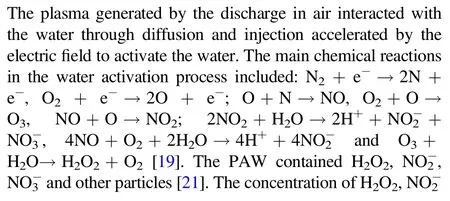

3.3.Survival of A.adsurgens Pall seeds
After culturing under different conditions,the survival rate ofA.adsurgensPall seeds is shown in figure 3.It can be seen from the figure that the survival rate of the CK is 43.3% and the survival rates of the plasma groups from 1 to 3 h were not significantly different from that of the CK.The survival rate ofA.adsurgensPall seeds in the plasma+PAW group was significantly different from that of the CK.The survival rates of the plasma+PAW groups were 21.3%,15.3% and 4%,respectively,and each group reached the half-lethal dose.With prolonged treatment time,the lethal effect became more obvious.In addition,when the treatment time was 3 h,the plasma group and the CK have basically the same survival rate.The survival rate of the plasma+PAW group treated for 3 h was very low(only 9.2%of that of the control group),so the 3 h treatment group was selected for ROS-content detection and RNA-Seq.
Table 2.Concentration of long-lived particles .

Table 2.Concentration of long-lived particles .
Treatment time NO2−(mg l−1)H2O2(mg l−1)NO3−(mg l−1)pH Conductivity(μS cm−1)1 h 0.397 4.544 39.321 3.39 186.40 2 h 0.110 9.034 117.644 3.02 391.67 3 h 0.004 15.417 335.084 2.65 915.67
3.4.ROS content
Plasma treatment led to the fluctuation of intracellular ROS,which mainly includedand ·OH[22,23].The lethal effect was obvious when the treatment time was 3 h,so the seedlings of the plasma and plasma+PAW groups treated for 3 h were selected for ROS measurement.As shown in figure 4,after 3 d of inoculation,the ROS content of the treatment group was significantly higher than that of the CK.The ROS content of the plasma+PAW group increased more significantly than that of the CK,and significant differences existed between the groups.On the sixth day after inoculation,the ROS content of each group was significantly lower than that on the third day and no significant difference existed between the groups.
3.5.RNA-Seq
Astragalus adsurgensPall seedlings of the CK,plasma and plasma+PAW groups with a treatment time of 3 h and cultured for 7 d were selected for RNA-Seq analysis,and more than 70% of unigenes were annotated into seven major databases.
3.5.1.Genetic difference analysis.In each group,some genes showed significant differences in gene expression.Among them,the number of differential genes in the CKversus-plasma group was small,and the number of differential genes in the CK-versus-plasma+PAW group and the plasma-versus-plasma+PAW group was large.In addition,compared with the CK,the number of upregulated genes in the plasma+PAW group was greater than the number of downregulated genes,the number of downregulated genes in the plasma group was greater than the number of upregulated genes and the upregulation of plasma+PAW genes was the most obvious,as shown in figure 5.
We drew a sample difference volcano map for the differential expression of genes between the three groups of CK-versus-plasma,CK-versus-plasma+PAW and plasmaversus-plasma+PAW(figure 6).The three groups of gene difference multiples were found to be concentrated in both sides of ±5.The number of genes with CK-versus-plasma upregulated gene difference fold greater than five was less than the number of genes with downregulated gene fold difference less than −5.The CK-versus-plasma+PAW and plasma-versus-plasma+PAW groups upregulated gene difference fold greater than five was more than the number of genes with downregulated gene fold difference less than −5,indicating that the expression of the plasma group was significantly downregulated compared with the CK,and the gene expression in the plasma+PAW group was upregulated significantly.
3.5.2.Enrichment analysis
3.5.2.1.KEGG pathway enrichment analysis.The enrichment of upregulated genes in the CK-versus-plasma group was significantly lower than that of the CK-versusplasma+PAW group,which was consistent with the results of the differential-gene volcano map.Bubble charts of the CK-versus-plasma KEGG pathway enrichment are shown in figures 7(a)and(b),and figure 7(a)shows that the CK-versus-Plasma group upregulated genes were in pentose and glucuronate interconversions,endocytosis,carbon metabolism,RNA transport and other pathways had a high degree of enrichment,promoted the mutual conversion rate of pentose and glucuronic acid and endocytosis of the plasma group seedlings,and promoted carbon metabolism.Genes that promote the synthesis of folic acid and carotenoids were highly enriched,as were genes that promote thiamine metabolism.Figure 7(b)shows that the number of downregulated genes annotated in phenylpropanoid biosynthesis,pentose and glucuronate interconversions,and endocytosis was large,and the expression of biosynthetic genes such as phenylpropane,monoterpenes,sesquiterpenes and triterpenes was downregulated.The expressions of selenium compounds,taurine and low taurine metabolism genes were downregulated and the enrichment was high.Fatty acids can be combined with other substances to form esters,and the ability to synthesize esters decreases.
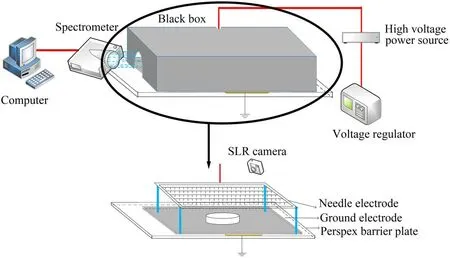
Figure 1.Needle array-plate DBD device.
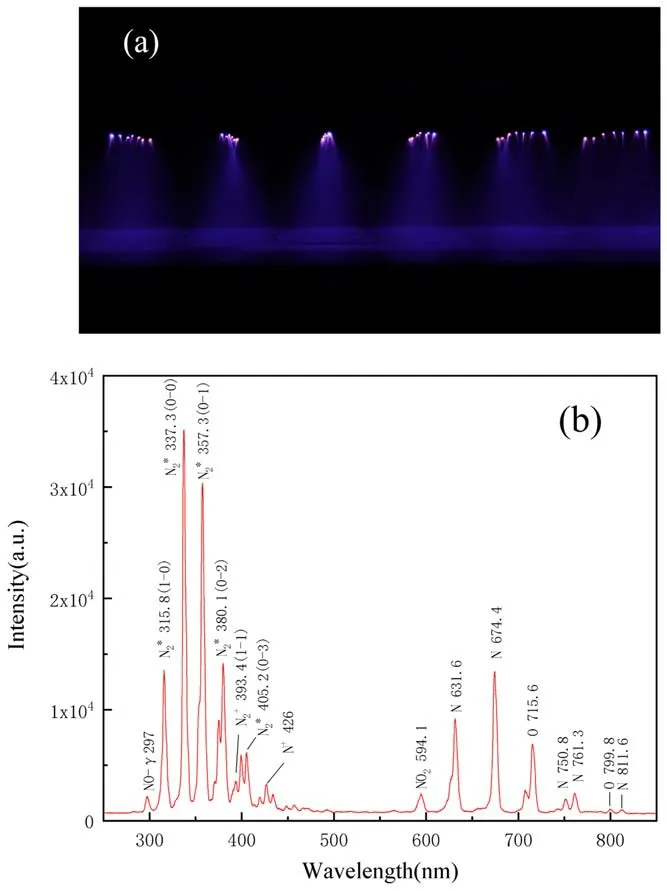
Figure 2.(a)Plasma-discharge image,(b)plasma-emission spectra:voltage of 25 kV and needle-dielectric plate distance of 4 cm(the distance from the needle tip to the water surface is 3.675 cm).

Figure 3.Survival rates(different letters indicate statistically significant differences between treatments(p<0.05)).
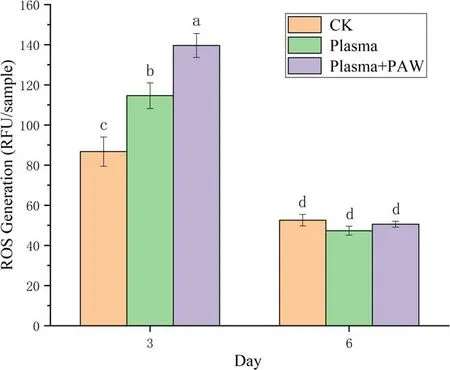
Figure 4.ROS content of A.adsurgens Pall seedlings treated for 3 h(different letters indicate statistically significant differences between treatments(p<0.05)).
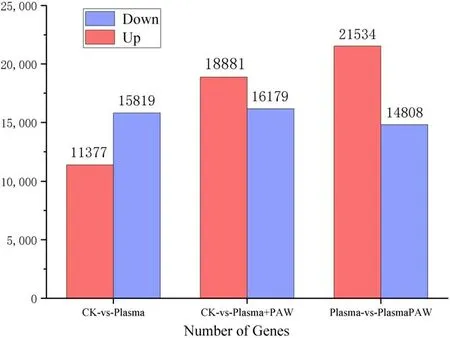
Figure 5.Statistics of the number of differential genes.

Figure 6.(a)CK-versus-plasma,(b)CK-versus-plasma+PAW,and(c)plasma-versus-plasma+PAW sample difference volcano map.
Bubble charts of the CK-versus-plasma+PAW KEGG pathway enrichment are shown in figures 8(a)and(b).Figure 8(a)shows that the number of upregulation genes annotated in RNA transport,RNA polymerase and ribosome pathways was large,and promoted RNA translation into protein.Peroxidase synthesis genes with higher enrichment,and amino acid synthesis and metabolism function were upregulated.These genes jointly promoted seed germination and photosynthesis,which was beneficial to crop growth.The process of carbon metabolism was promoted and the number of upregulated genes was three times that of the plasma group.The biosynthesis and metabolism functions of fatty acids were promoted.Figure 8(b)shows that there were more downregulated genes in pentose and glucuronate interconversions,amino sugar,nucleotide sugar metabolism,spliceosome,plant–pathogen interaction and RNA transport pathways.Downregulated expression of these genes slowed glucose metabolism.There was a large number of downregulated biosynthesis genes in phenylpropanoid,which may lead to the weakened ability of seedlings to respond to stress[24].The function of plant–pathogen interaction was weakened.
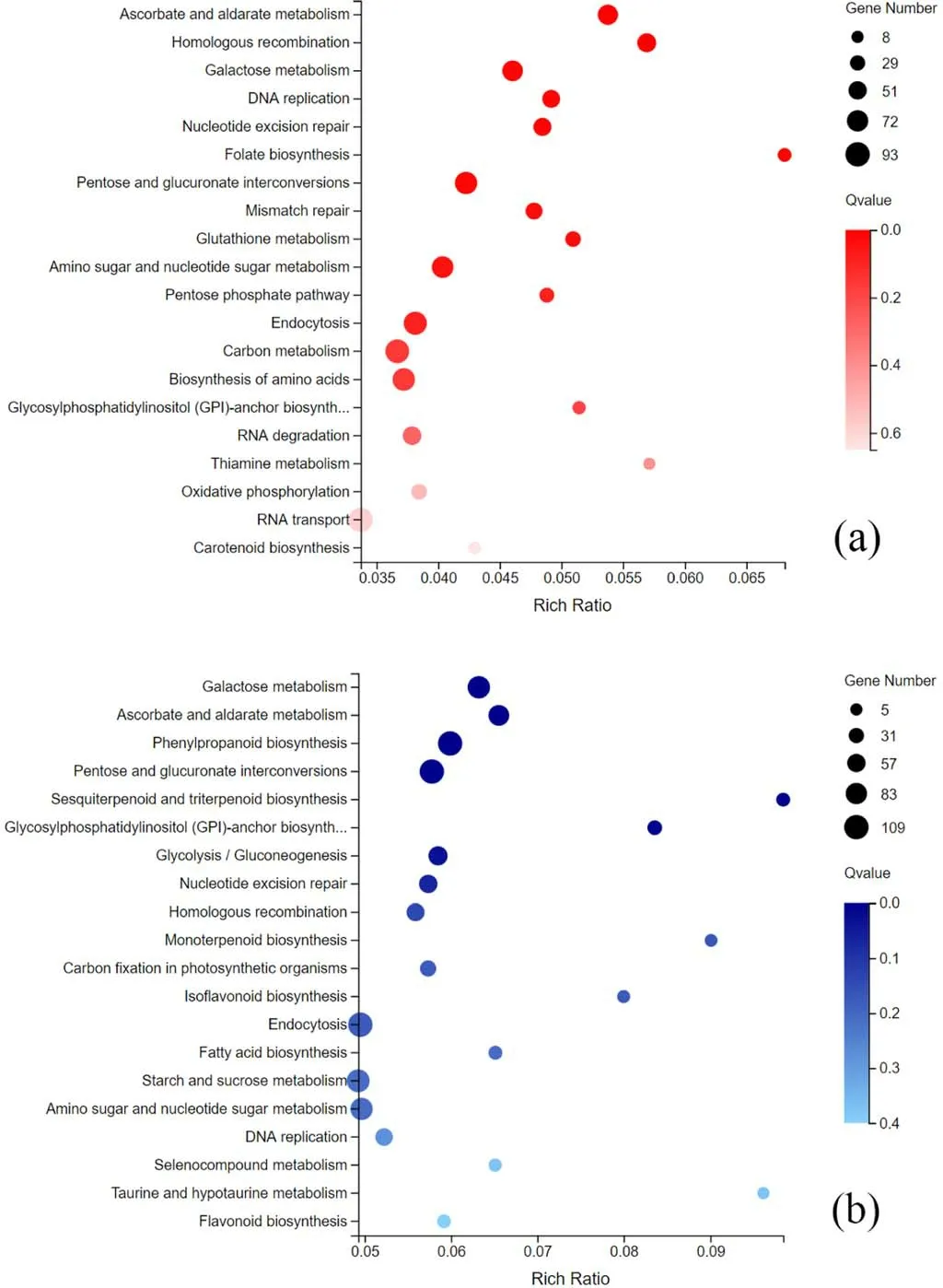
Figure 7.Bubble charts of KEGG pathway enrichment.(a)CK-versus-plasma upregulated gene expression,(b)CK-versus-plasma downregulated gene expression.
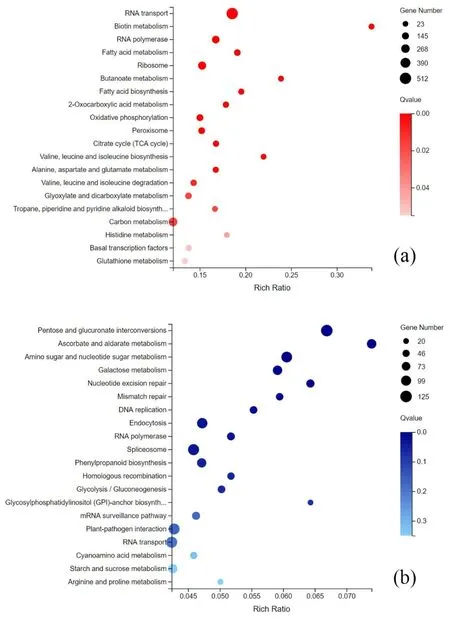
Figure 8.Bubble charts of KEGG pathway enrichment.(a)CK-versus-Plasma+PAW group upregulated gene expression,(b)CK-versus-Plasma+PAW downregulated gene expression.
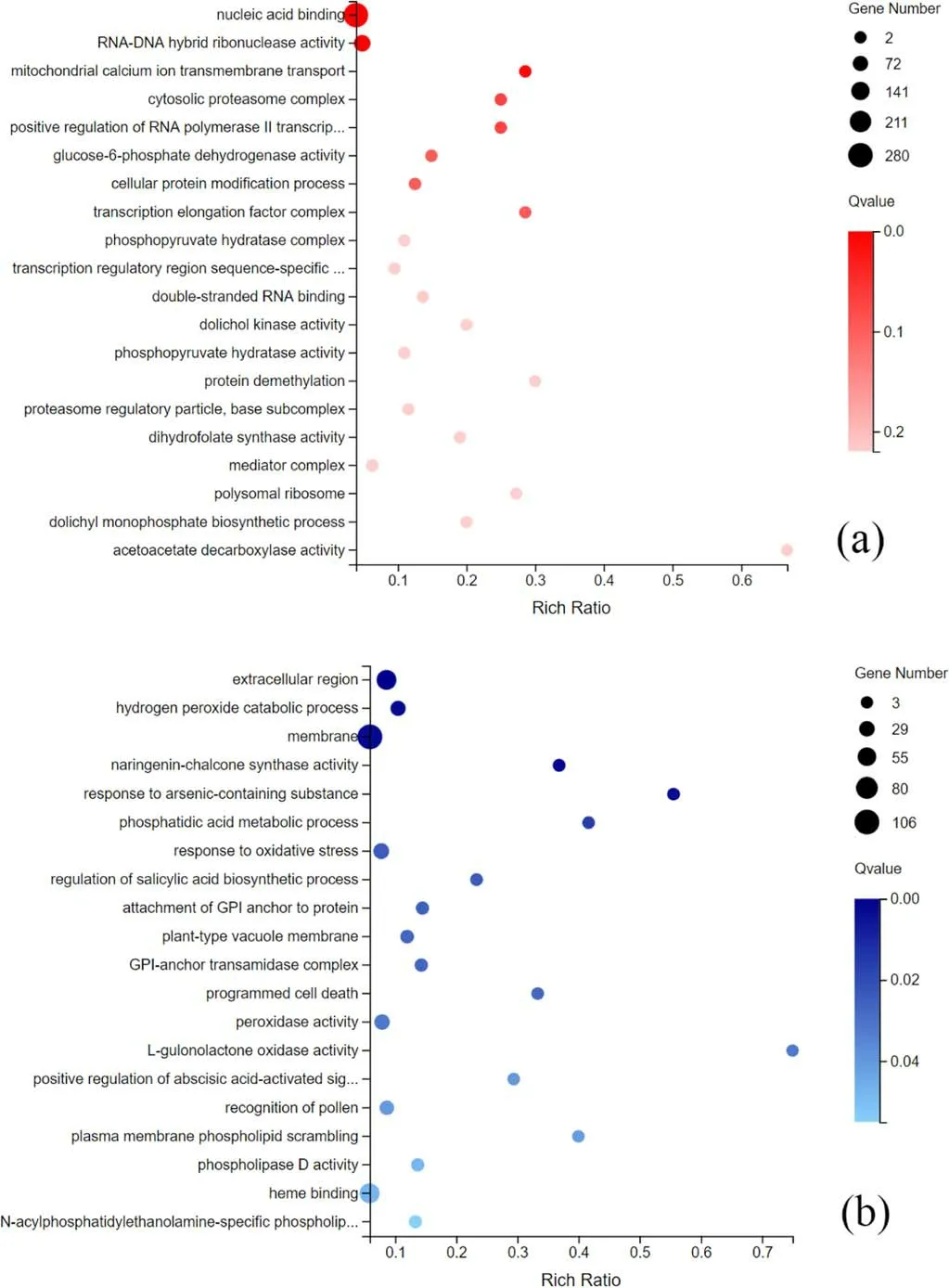
Figure 9.Bubble charts of GO annotation enrichment.(a)CK-versus-plasma group upregulated gene expression,(b)CK-versus-plasma group downregulated gene expression.
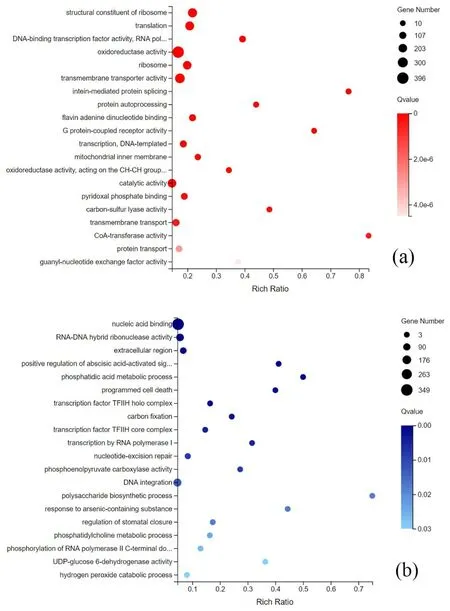
Figure 10.Bubble chart of GO annotation enrichment.(a)CK-versus-plasma+PAW upregulated gene expression,(b)CK-versus-plasma+PAW downregulated gene expression.
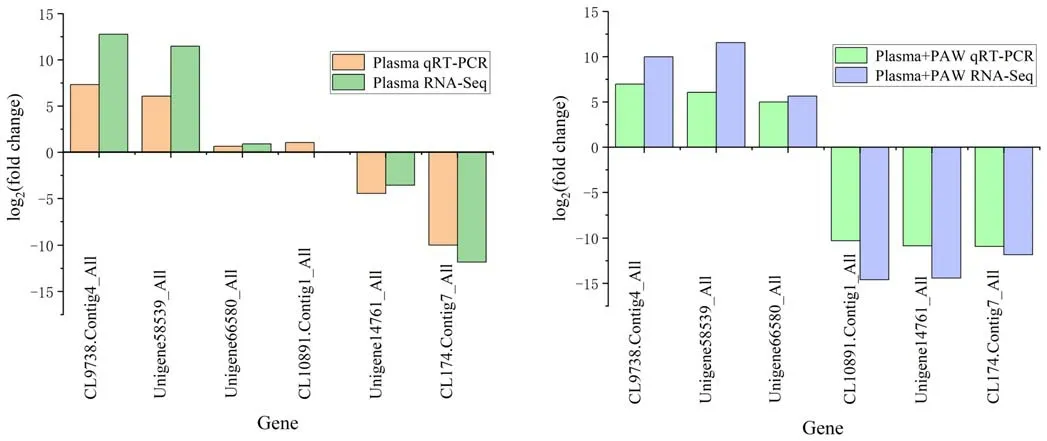
Figure 11.qRT-PCR verification of differentially expressed genes.
3.5.2.2.GO enrichment analysis.Bubble charts of the CKversus-Plasma GO annotation enrichment are shown in figures 9(a)and(b).The GO enrichment bubble chart of upregulated genes is shown in figure 9(a).The figure showed that there were a large number of genes annotated with nucleic acid binding.In addition,the enrichment degree of the upregulation gene annotations was high on dolichol kinase activity,phosphopyruvate hydratase activity,dihydrofolate synthase activity and acetoacetate decarboxylase activity,and the enrichment degree of genes promoting transcription and translation was also high.A large number of genes with RNA-DNA hybrid ribonuclease activity function were upregulated.These genes can change host-cell metabolism and inhibit virus synthesis,which was of great significance to organisms.The bubble chart of the GO enrichment of downregulated genes is shown in figure 9(b).There were more genes annotated in membrane.Genes annotated in hydrogen peroxide catabolic process,response to oxidative stress and peroxidase activities have a higher degree of gene enrichment,indicating that the plasma group seedlings were less able to decompose peroxides.
Bubble charts of the CK-versus-plasma+PAW GO annotation enrichment are shown in figures 10(a)and(b).The GO enrichment bubble chart of upregulated genes is shown in figure 10(a).It can be seen from the figure that the number of upregulated genes annotating a structural constituent of ribosome,translation and transmembrane transporter activity was large.They promote the translation of RNA into protein,redox reactions and transmembrane transport;the expression of genes with oxidoreductase activity is upregulated in plants.The redox effect in the body is promoted and the expression of genes with pyridoxal phosphate binding function is upregulated.This compound is clinically used as a drug for the treatment of Parkinson’s syndrome,which can promote the transaminase effect of transaminases and increase the content of dopamine in the body.The GO enrichment bubble chart of downregulated genes is shown in figure 10(b).There were many genes annotated in nucleic acid binding,and the expression of genes that promoted sugar synthesis was significantly downregulated.
3.5.3.Differential-gene analysis.Among the differential genes,20 genes in each group with the largest fold difference in expression of upregulation in the treatment group were screened out(table 3).Genes numbered 1–20 were upregulated most significantly in plasma+PAW;genes numbered 21–40 were upregulated most significantly in the plasma group.These genes were not expressed in the CK.
Genes 1–20 were not expressed in the plasma group or had a low expression level,and the expression level was the highest in the plasma+PAW group.Among them,genes 1,3,4,8,9,10 and 13 were involved in membrane composition;gene 3 had the function of directing the synthesis of HSP20 family protein.Under the stimulation of higher-than-normal growth temperature,it induced new protein synthesis,prevented protein denaturation,and restored the original spatial conformation and biological activity.Gene 2 had the function of synthesizing carboxymethylenebutenolidase and was a promoter of plant seed germination.The fragments per kilobase million(FPKM)value of this gene in the plasma+PAW group reached 848.58,with a high expression level.Genes 4 and 8 directed the synthesis of nuclear-pore complex proteins.Gene 4 guided and promoted carotenoid biosynthesis.Genes 6 and 8 guided the synthesis of pectinesterase,which was used to catalyse the hydrolysis of the methoxy ester of pectin to produce pectic acid.Gene 7 promoted plant growth;gene 10 improved transmembrane-transport protein
activity;genes 4,14 and 15 promoted oxidoreductase activity and accelerated redox reactions;genes 6,9,16–18 guided the synthesis of interleukin-1 receptor-associated kinase.Gene 11 had the function of synthesizing peroxidase,directing the synthesis of nuclear-pore complex protein and directing the synthesis of interleukin-1 receptor-associated kinase.Gene 13 had the function of synthesizing superoxide dismutase and scavenging superoxide free radicals.This finding corresponded with the change in ROS content.The effect of plasma+PAW caused a substantial increase in ROS content.Plants responded to the stimulation of ROS.Gene 13 was expressed in large quantities,causing a decrease in ROS.In the plasma+PAW group,membrane formation,material transport,redox reaction and carotenoid genes guiding the synthesis of animal health were promoted.
Genes 21–39 were not expressed in the plasma+PAW group or had a low expression level,and the expression level was the highest in the plasma group.Gene 21 had the function of synthesizing nucleolins,which were not only directly involved in the biosynthesis and maturation of ribosomes,but also directly or indirectly involved in cell proliferation,growth,embryogenesis,cytokinesis,chromatin replication and nucleolus formation.Genes 22,26,28,38 and 39 were part of the synthetic membrane,and the transmembrane transport of the surviving seedlings in the two treatment groups was promoted;gene 23 promoted the process of carbohydrate metabolism,and also directed the synthesis of phosphoribulose 3-epimerase,which was responsible for the biosynthesis of ribose in the pentose phosphate pathway(also known as the hexose phosphate branch).Mutual transformation and organic connection of the pentose phosphate pathway with the glycolysis process had important biochemical significance.Genes 24 and 25 can guide the synthesis of zinc transporters and promote zinc absorption,extracellular to intracellular zinc transport and intracellular zinc transfer in plants.These genes were upregulated in the plasma group.Members of the ZIP transporter family have been identified inArabidopsis thaliana,Triticum aestivumL,Lycopersicon esculentum,Glycine max(Linn.)Merr.,Oryza sativaL and other plants.Genes with this function have been detected inA.adsurgensPall for the first time[25–27].Genes 26,27,31 and 38promoted chloroplast growth;genes 30 and 35 promoted DNA binding.Gene 31 directed the synthesis of protoporphyrin O-methyltransferase and promoted chlorophyll synthesis.Gene 36 promotes the process of cell division;gene 40,a component of the synthesis membrane,promotes chloroplast growth and plant photosynthesis,and the upregulated multiple of this gene in each group was more than 12,indicating that photosynthesis was promoted in all treatment groups.
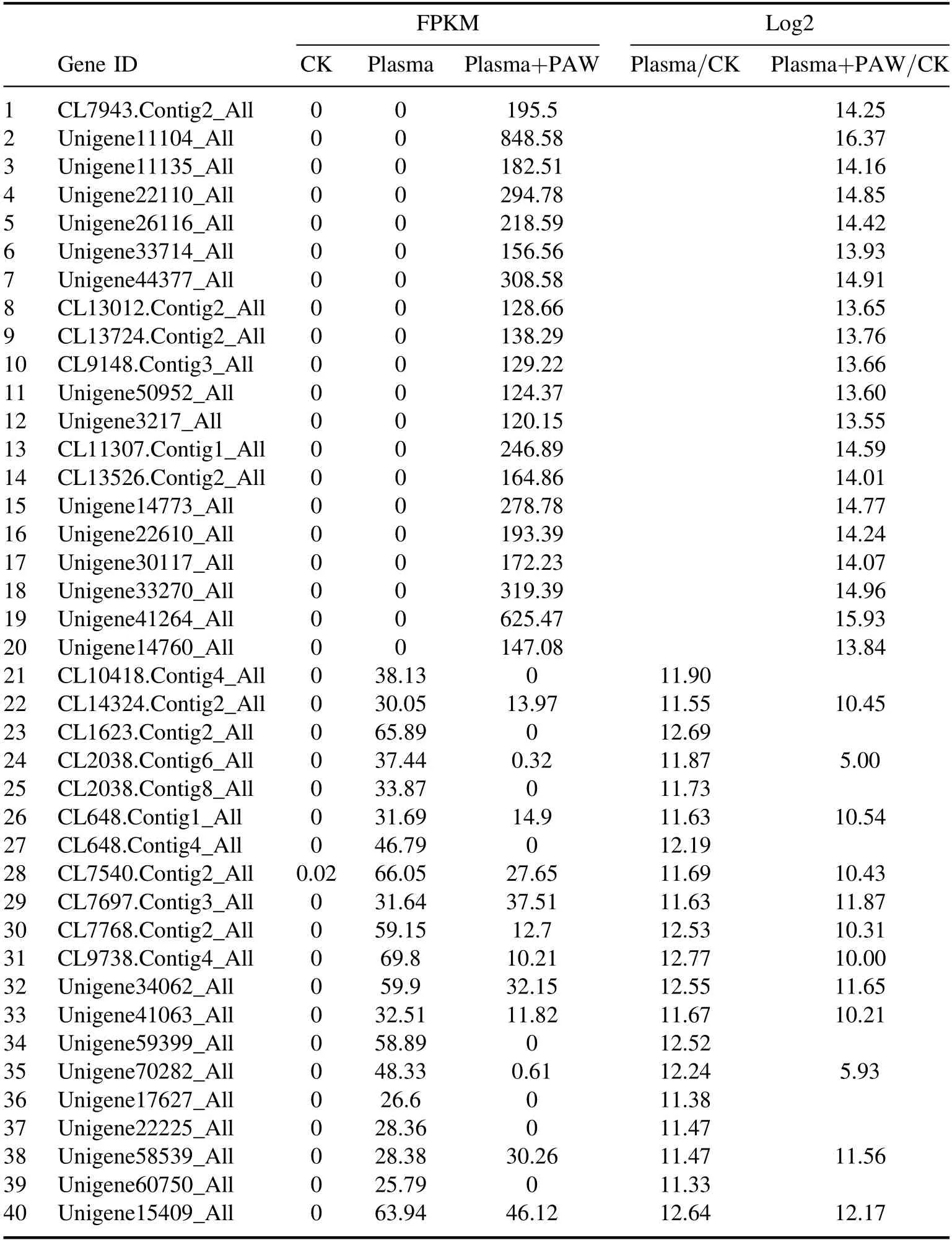
Table 3.Significantly upregulated genes after treatment.
Among the differential genes,20 genes in each group with the largest fold difference in the expression downregulation of the treatment group were screened out(table 4).Genes 1–14 were most significantly downregulated in the plasma+PAW group,genes 1–32,33 and 34 were downregulated most significantly in the plasma group,genes 15–17 were downregulated most significantly in the plasma+PAW and plasma groups.These genes were highly expressed in the CK.
Genes 1,2 and 11 were not expressed in the plasma+PAW group but were upregulated in the plasma group.Genes 1 and 2 can regulate cell-wall synthesis,promote metabolism,guide the synthesis of xyloglucosyl transferase,hydrolyse O-glycosyl compounds and participate in the metabolism of xyloglucan.Gene 11 promotes the defence response to bacteria,responds to cold,promotes chloroplast thylakoid membrane formation and promotes photosynthesis.
Genes 21–24 were not expressed in the plasma group but were upregulated in the plasma+PAW group.Gene 21promotes respiration;gene 22 has functions such as promoting photosynthesis and responding to light stimuli.Gene 23 directs the production of mucin;gene 24 has the function of oxidoreductase synthesis.
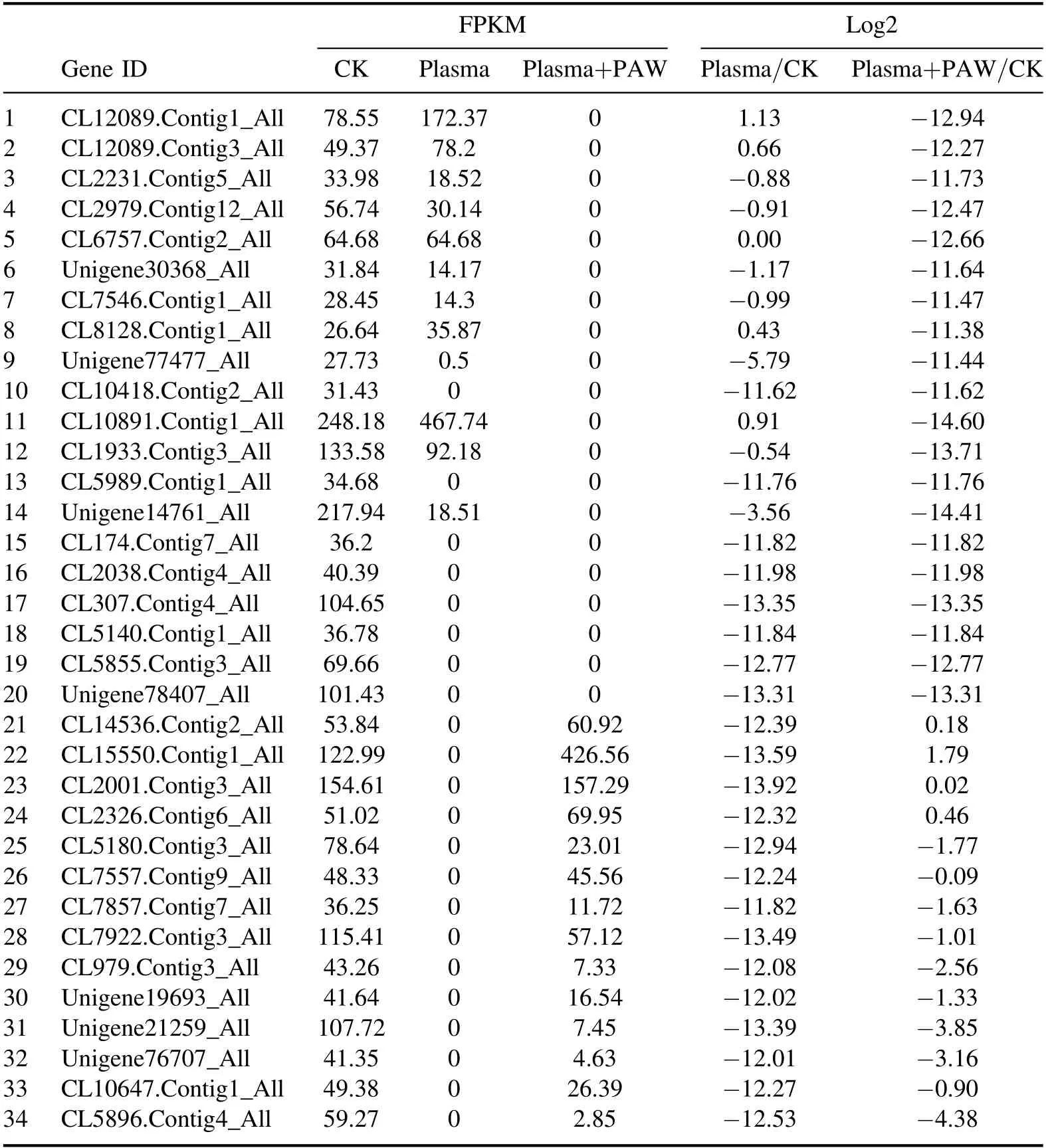
Table 4.Significantly downregulated genes after treatment.
Genes 9,15 and 16 were almost not expressed in the two treatment groups.Gene 9 directs the synthesis of βglucosidase;gene 15 regulates cell-wall synthesis,participating in the process of carbohydrate metabolism and directing the synthesis of β-galactosidase;and gene 16 has the function of synthesizing peroxidase.
The expression of other genes was downregulated in the treatment group.Gene 3 regulated cell-wall synthesis and participated in the process of carbohydrate metabolism.It can synthesize basic endochitinase B,which has helpful plant antibacterial and antiviral activities.Genes 5 and 18 were involved in the composition of membranes;gene 12 directed the synthesis of transketolase.Gene 19 had the function of synthesizing peroxidase.Gene 25 directed the synthesis of large subunit ribosomal protein L1,and gene 31 directed the synthesis of small subunit ribosomal protein S25e.Large subunit ribosomal protein and small subunit ribosomal protein participate in the formation of ribosomes.Gene 27 had the function of synthesizing oxidoreductases,promoting the biosynthesis of ultra-long-chain fatty acids,participating in the synthesis of seed glycerides,biomembrane lipids and sphingolipids,and providing precursors for the biosynthesis of stratum corneum wax.Gene 29 was involved in membrane composition.Genes 30 and 32 synthesized serine/threonine kinase,asparagine synthase and promoted the metabolism of glutamine.Gene 33 can direct the synthesis of deoxyribodipyrimidine photolyase and repair DNA damage caused by ultraviolet rays.
3.5.4.qRT-PCR verification.The qRT-PCR verification results showed that,compared with the CK,these genes were differentially expressed and the differential expression trend was consistent(figure 11),indicating that the analysis results of differentially expressed genes using the RNA-Seq method were reliable.
4.Discussion
In this work,a needle array-plate DBD device,a discharge voltage of 25 kV and a needle-dielectric plate distance of 4 cm were used to treatA.adsurgensPall seeds and deionized water,and the plasma-emission spectra under this condition were collected.The analysis of the spectra found that the plasma contains particles such as O,NO2,N2∗,N+,N2+and NO−γ,which provide theoretical guidance for subsequent experiments.The discharge plasma acts on the epidermis of the seed,which has a physical and chemical etching effect on the seed coat and improves the hydrophilicity of the seed[4].
In this study,the PAW obtained by long-term treatment had the characteristics of high long-lived particle concentration and low pH.The H2O2concentration of the treatment group for 3 h is 15.4 mg l−1,the NO2−concentration is 0.004 mg l−1and the NO3−concentration is as high as 335.1 mg l−1.The pH value is 2.65 and the conductivity is 915.67 μS cm−1.There was no significant difference in the survival rate ofA.adsurgensPall in the plasma group compared with the CK.After the seeds ofA.adsurgensPall were etched by discharge plasma,they were cultured with PAW.The high concentration of ROS in PAW takes water as the carrier and it was easier to reach the embryo of the seed,causing serious oxidative stress damage to the seed.In addition,the genetic material was damaged and repaired,causing genetic mutations.The plasma+PAW group reached the half-lethal dose compared with the CK.The survival rate of the plasma+PAW group at 3 h was only 4%.The embryos were severely damaged,which was very likely to cause a large number of gene mutations.
Studies have shown that ROS play an important role in cell proliferation,differentiation,apoptosis and have the function of signal molecules.ROS is an important marker connecting the physical and biological interpretation of the electromagnetic causal chain[28].In the plasma and plasma+PAW set of seeds,plants were stimulated by the outside world and a large amount of ROS accumulated in plants in a short time.The content of ROS in seedlings cultured for 3 d was significantly different from that of the CK.However,because it was easier for PAW to reach the embryo through the seed coat,the content of ROS in the seedlings cultured for 3 d in the plasma+PAW group was significantly higher than that in the plasma group.Excessive ROS content breaks the balance of ROS and its scavenging system,that is,the protective enzyme system,leading to the upregulation of the expression of genes with the functions of synthesizing superoxide dismutase and scavenging superoxide free radicals.RNA-Seq results showed that the expression of CL11307,Contig1_All,Unigene58539_All and other genes that promote oxidoreductase activity was significantly upregulated.Accordingly,ROS were eliminated.After 6 d of seedling inoculation,the ROS concentration in each group was basically the same.
The analysis of genes with higher differential gene enrichment degree and different multiples showed that some gene enrichment and gene expression of the plasma and plasma+PAW treatment groups had the same trend:the process of carbon metabolism was promoted and the number of upregulated genes in the plasma+PAW group reached three times the number of that in the plasma group.The photosynthesis and carbohydrate conversion functions were enhanced,and the enhancement effect in the plasma+PAW group was more obvious;both groups showed that carotenoid gene expression was upregulated.Carotenoid is the main source of vitamin A in the body,which is beneficial to animal health.Phenylpropanoid biosynthesis genes were downregulated in the plasma group in a large number,which may lead to the weakening of the ability of seedlings to respond to stress[24].It was also significantly downregulated in the plasma+PAW group,but the number of downregulated genes was slightly lower than that in the plasma group.The expression of genes that regulate cell-wall synthesis was downregulated in the two groups,the expression of sugar metabolism genes in the two groups was downregulated,the expression of genes that instructed the synthesis of deoxyribopyrimidine photolyase was downregulated and the repair function of DNA damage caused by ultraviolet rays was reduced.
The enrichment and expression of some genes in the two treatment groups showed opposite trends:in the plasma group,the expression of a large number of genes with nucleic acid binding function was upregulated.RNA-DNA hybrid ribonuclease activity genes were upregulated in a large number,which can change host-cell metabolism and inhibit virus synthesis,which is of great significance to organisms.However,the nuclear acid binding gene in the plasma+PAW group was significantly downregulated,and the RNA-DNA hybrid ribonuclease activity function was weakened.The expression of fatty acid synthesis genes in the plasma group was downregulated,and fatty acids were combined with other substances to form esters,indicating that the ability to synthesize esters decreased,while the fatty acid synthesis and metabolism genes in the plasma+PAW group showed an upregulation trend.Gene enrichment analysis revealed that genes with oxidoreductase activity and transmembrane transporter activity functions in the plasma group were suppressed.In the plasma+PAW group,the expression of these two functional genes was upregulated.The redox function in plants was promoted,the transmembrane-transport function was promoted.The expression of membrane composition genes also showed the same trend of change.
High enrichment of folate and carotenoid biosynthesis was detected in the plasma group.Folate is a water-soluble vitamin.An appropriate amount of folic acid can promote animal weight gain,which is beneficial to animal husbandry.Monoterpenoid,sesquiterpenoid and triterpenoid biosynthetic gene expression was downregulated,which had a negative effect on the synthesis of terpenoids.Genes that direct the synthesis of zinc transporters were also detected in the plasma group.Zinc transporters promote the absorption of zinc in plants,the transfer from extracellular to intracellular and the transfer of intracellular zinc,which play an important role in plant growth.
The plasma+PAW group contains highly enriched genes for RNA transport,RNA polymerase,translation,ribosome and various amino acid synthesis and metabolism functions,which promotes seedling transcription,translation and protein synthesis.The expression of genes with pyridoxal phosphate binding function was upregulated.This compound is clinically used to treat Parkinson’s syndrome.It promotes transaminase to carry out transamination and increases the content of dopamine in the body.The expression difference in the plasma group was not obvious.The plasma+PAW group had the function of instructing the synthesis of HSP20 family protein gene expression upregulation.Under the stimulation of higher than normal growth temperature,it induces new protein synthesis,prevents protein denaturation and restores its original spatial conformation and biological activity.The expression of a gene with the function of synthesizing carboxymethylene butenoidase was upregulated.This gene FPKM reached 848.58,with a high expression level.It is a promoter of plant seed germination.
Based on the above analysis,it was found that a large number of gene expression changes following plasma and plasma+PAW treatments.In the Plasma+PAW group,the expression of genes that promote plant growth was significantly upregulated,and the expression of genes such as synthetic carotenoids was upregulated.Based on genesequencing results,the treated seedlings ofA.adsurgensPall may grow faster and have higher nutritional value.The results also showed that the gene enrichment and gene expression of the plasma and plasma+PAW treatment groups are different,indicating that the damage caused by the two treatments is different,as well as the molecular mechanism.Compared with the plasma group,the damage caused by the plasma+PAW treatment is more severe,it can also cause a large number of mutations,so the synergistic effect of discharge plasma and PAW can be applied to the mutation breeding ofA.adsurgensPall,which is of great significance to the mutation breeding ofA.adsurgensPall.
5.Conclusions
(1)After long-term treatment,the survival rate of seedlings in the plasma group was lower than that in the CK,but the difference was not significant.The survival rate of the seeds in the plasma+PAW group was greatly reduced,and the survival rate of the 3 h treatment group was the most significant.
(2)The ROS content of seedlings inoculated for 3 d was significantly higher than that of the control group(CK<plasma<plasma+PAW).Due to the function of synthesizing superoxide dismutase,scavenging superoxide free radicals and promoting the upregulation of gene expression of oxidoreductase activity,in a culture on the sixth day,the ROS contents of the plasma and plasma+PAW groups were not significantly different from that of the CK.
(3)After treatment with plasma+PAW,a large number of genes ofA.adsurgensPall seedlings were upregulated,genes that promote plant growth were significantly upregulated and genes that synthesize carotene were upregulated.
(4)The co-processing of plasma and PAW is an environmentally friendly physical and chemical mutagen with obvious mutagenic effects.
Acknowledgments
This work is supported by National Natural Science Foundation of China(Nos.51767020 and 52067017),the Inner Mongolia Autonomous Region Science and Technology Plan Project(No.2020GG0280),and the Natural Science Foundation of Inner Mongolia Autonomous Region(Nos.2019MS06025 and 2020MS01016).
 Plasma Science and Technology2022年7期
Plasma Science and Technology2022年7期
- Plasma Science and Technology的其它文章
- Special issue on selected papers from CEPC 2021
- Highly efficient γ-ray generation by 10 PWclass lasers irradiating heavy-ion plasmas
- Surface properties of Al-doped ZnO thin film before and after CF4/Ar plasma etching
- Photoexcited carrier dynamics in a GaAs photoconductive switch under nJ excitation
- Microwave method based on curve fitting method for high-precision collision frequency diagnosis
- Inverse synthetic aperture radar range profile compensation of plasma-sheathenveloped reentry object
